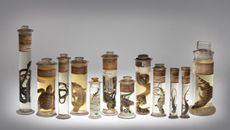The enduring appeal of Agatha Christie
It’s a year of anniversaries for fans of Agatha Christie but what’s behind her enduring appeal?


Abney Hall in Cheadle, with its many gables, clusters of chimney-stacks and stone mullions to the exterior, its interior a polychrome Gothic Revival extravaganza by J. G. Crace, would provide the fictional setting for a number of Agatha Christie's novels. It appears as Rutherford Hall in 4.50 From Padding-ton; in After the Funeral, it is described as ‘a proper old mausoleum'; masquerading as Stonygates in They Do It With Mirrors, it's dismissed as a ‘sort of Gothic monstrosity... Best Victorian Lavatory period'. She remembered its ‘quantities of rooms, passages, unexpected steps, back staircases, front staircases, alcoves, niches'.
The young Agatha loved Abney Hall. It was the married home of her sister Madge, 11 years Agatha's senior. It also inspired Agatha's first novel. The Mysterious Affair at Styles, in which it vied for attention with the first appearance of her Belgian sleuth, Hercule Poirot, was published 90 years ago.
The author had recently celebrated her 30th birthday. Ten years later, in The Murder at the Vicarage, she produced her first full-length novel to feature ‘a white-haired old lady with a gentle, appealing manner'-Miss Jane Marple. In the same year, she also published the first of her non-detective novels, Giant's Bread, written under the pseudonym Mary Westmacott. For aficionados of the author, 2010 is a year of special anniversaries.
Agatha owed more to her sister Madge than happy memories of lavish Christmases at Abney. Without her taunting, Agatha might never have turned her hand to detective fiction and thus never have entered the record books as the best-selling writer of all time. Today in Britain, more than 30 years after their author's death, her novels continue to sell in the region of 600,000 copies a year.
Her work has been translated into 103 languages. There have been more than 100 British TV adaptations and some 30 feature films. The Mousetrap, originally written as a radio play in honour of Queen Mary's 80th birthday, has been running in London since 1952. Would any of this have happened had Agatha and Madge not both read Gaston Leroux's The Mystery of the Yellow Room of 1908 and Madge subsequently dismissed her younger sister's chances of pulling off a similar detective story?
Eight years passed before Agatha wrote The Mysterious Affair at Styles. It was the middle of the First World War. She was married to her first husband, airman Archibald Christie, and working at the Torquay dispensary close to the house she continued to share with her widowed mother, Clara Miller. A new knowledge of poison, the result of her work at the dispensary, gave her a plot and when her mother sent her on her own to Dartmoor, she finished the novel in a fort-night. Afterwards, the momentum slowed. It would be four years-and several rejections-before her first novel was published, by John Lane of The Bodley Head, on terms more advantageous to Lane than Agatha.
Then, for the first time, the reading public encountered ‘an extraordinary-looking little man... His head was exactly the shape of an egg... His moustache was very stiff and military. The neatness of his attire was almost incredible; I believe a speck of dust would have caused him more pain than a bullet wound. Yet this quaint dandified little man... had been in his time one of the most celebrated members of the Belgian police.'
Sign up for the Country Life Newsletter
Exquisite houses, the beauty of Nature, and how to get the most from your life, straight to your inbox.
Poirot went on to feature in 32 further novels and more than 50 short stories. His ‘death' resulted in an obituary in The New York Times. Despite his overt, even heavy-handed foreignness, he, like his half-American creator (Agatha's father Frederick Miller was a New Yorker) has become an icon of British popular culture. So, too, has his sister-in-crime, Miss Marple.
In 1930, British reviewers responded positively to Agatha's new departure. The Sunday Review of Literature stated: ‘When [Agatha Christie] hits her stride in a full-length detective story, as she does in The Murder at the Vicarage, she is hard to surpass.' Agatha's new detective was inspired by her grandmothers and named after a country house close to Abney called Marple Hall, where Agatha bought at auction a pair of Jacobean chairs she would keep until her death. Along with Miss Marple, whose working method was principally intuitive-the means Agatha devised for enabling an elderly spinster with apparently no emotional life to fathom the darker wells of the human heart-came St Mary Mead.
The fictional village has become for readers across the world the quintessence of a certain sort of English country life. Miss Marple solves crimes not by forensic science or elaborate theories, but through her knowledge of human nature gleaned from the everyday happenings of St Mary Mead. As she herself says: ‘Very painful and distressing things happen in villages sometimes.'
Eighty years after Agatha created Miss Marple, her novels continue to attract new readers not only on account of their unguessable plots, but their evocation of a vanished world of country life that strikes deep chords in the British psyche and reminds readers across the world that at heart this remains a green and pleasant land-albeit one in which, as in Miss Marple's village, very painful and distressing things can happen.
At the outset of her career, Agatha claimed: ‘I had an idea that writing books was only the natural successor to embroidering sofa-cushions.' In this year of major Christie anniversaries, we must be grateful that she did not choose to confine herself to interior decoration.
This year's Agatha Christie Week, September 12-19-her birthday was the 15th-will have events in Torquay, the author's home town, and around the country. For details, visit www.agathachristie.com
Country Life is unlike any other magazine: the only glossy weekly on the newsstand and the only magazine that has been guest-edited by HRH The King not once, but twice. It is a celebration of modern rural life and all its diverse joys and pleasures — that was first published in Queen Victoria's Diamond Jubilee year. Our eclectic mixture of witty and informative content — from the most up-to-date property news and commentary and a coveted glimpse inside some of the UK's best houses and gardens, to gardening, the arts and interior design, written by experts in their field — still cannot be found in print or online, anywhere else.
-
 LAPICIDA — Tile & Stone Specialist
LAPICIDA — Tile & Stone SpecialistLapicida is a world-class specialist in luxury surfaces.
By Country Life Published
-
 What lies beneath: The weird and wonderful things lurking in Britain's museum basements
What lies beneath: The weird and wonderful things lurking in Britain's museum basementsFrom radioactive rocks to great white sharks, and a dolphin called Boris, the things stored in Britain's museum basements make the mind boggle — and now plans are afoot to improve visitor access.
By Deborah Nicholls-Lee Published
